SIDE EFFECTS
Over a year after her son’s death, Libby Davis hopes to make a lasting impact on her community
PAGE 4
New guidelines over gender and pronouns affect students
PAGE 7
Common dreams and their meanings and the science behind dreams
PAGE 13
How two female coaches at MV are paving a path in a male-dominated world
Mill Valley High School Shawnee, Kansas Volume 23 Issue 1 September 27, 2022JW
JagWire Office
5900 Monticello Road
Shawnee, KS 66226
Phone: (913) 422-4351

Fax: (913) 422-4039
Email: jagwirenewspaper@gmail.com
Adviser: Kathy Habiger khabiger@usd232.org
JagWire, a monthly publication of Mill Valley High School, is printed by Valley Offset Printing
Professional Associations
Kansas Scholastic Press Association
National Scholastic Press Association
Journalism Education Association
Journalism Educators of Metropolitan KC
The 2022 JagWire earned an All-American rating from NSPA and an All-Kansas rating from KSPA. It is also a member of the NSPA All-American Hall of Fame.
Editorial Policy
We value your opinions. If you wish to submit a column or a letter to the editor to the JagWire, you can do so by handing it in to a member of the staff or to the print journalism room (C101). Addi tionally, you may email any member of the staff with opinions, as well as tweet us at @millvalleynews. Anonymous content will not be accepted. Please understand that we have the right to edit all copy that runs in this publication.
Censorship Policy
The Kansas Student Publications Act guarantees the same rights for student journalists as are guaranteed for professional journal ists. These rights include, but are not limited to, all First Amend ment rights, including the rights of freedom of speech and the press, insofar as published items may not contain libelous, slan derous or obscene statements, may not incite or promote illegal conduct and may not cause a substantial disruption to normal school activity. This law also prevents censorship of any kind by the adviser, building or district administration.
Sydney
Anna
Leah
Maggie
Hailey
Abby Riggs
Ian Chern
Kai Tolly
Luci Guess
Julia Shumaker Sept. 27, 2022Table of Contents2 3 4 6 7 12 13 2022 -23 STAFF @millvalleynews @millvalleynews1 @MillValleyNews
PUBLICATION INFORMATION Editor in Chief Avery Gathright Online Editors in Chief Gabby Delpleash Emma Clement IN THIS ISSUE Photo Editors Luke Wood Elizabeth Summa Design Editors Chloe Miller Copy Editors Natalie Merley Baylen Monson Social Media Editors Grace Brookshire Katelyn Krosky Reporters & Photographers
McGlasson Madelyn Welch
Dresvyannikov
Perrin
Zwahlen
Wieland OPINIONS STAFF EDITORIAL NEWS PRONOUNS GUIDELINES FEATURES EQUESTRIANS GRAPHICS DARE TO DREAM FEATURES COOPER DAVIS UPDATE 8 OPINION POLITICAL TOLERANCE IS A TWO-WAY STREET SPORTS FEMALE FOOTBALL COACHES 14 A&E BE REAL 15 A&E HANGOUT SPOTS 16 PHOTO ESSAY ART CLASSES
Staff
Redraft and Reassess
by jagwire staff
As the new school year begins, so does the age-old practice, known all too well by stu dents and teachers alike, of getting to know new names. But, for the first time this year, De Soto district teachers will learn student preferred names, and in many cases pronouns, preferred under a new set of guide lines titled “Guidance Related to Gender Identity.”
The guidelines say that teachers are to report to administration if a student wants to go by a different name or pronouns, and they believe it could indicate a gender change. Administration would then contact a counselor and social worker, who would then reach out to the student’s guardian for permission to call the student what they prefer.
As the JagWire staff discussed what we would promote as our opinion on the guidelines, we did so knowing this would be one of the more con troversial opinions we would publish in a staff editorial, with it is a guid ance that directly affects Mill Valley students. We came to the conclusion that the guidelines, though well intended, are doing more harm than good.
It has not gone without notice that those who created the guide lines likely genuinely wanted to help protect the school and teachers from
seemingly going behind parents’ backs and having to field through lawsuits, but ultimately the JagWire staff believes that students should be put first.
The guidelines tell administra tors that they are required to report a gender-related name change to
Though in many cases, students are alerted that their parents will be contacted, this is not enough. Students should be involved in a conversation about their safety in expressing gender identity at home before talking to a parent before the changes are considered.
Additionally, while it is import ant to approach certain aspects of this process on a case-by-case basis, the guidelines as a whole should be much more specific on what the pro cess would actually look like for a student interested in having a gender change approved by the district.
guardians, and this is not safe for many gender non-conforming stu dents. For gender non-conforming teenagers, a parent finding out their gender before they are ready to talk about it can not only be traumatic, but also life-altering.

According to the Washington Post, LGBTQ youth represent 7% of the homeless population in the United States, and the main causes are due to familial rejection leading to running away or being kicked out.
Specificity in guidelines would best be gained by creating an actual policy passed by the Board of Ed ucation, in which a gender change process is clearly outlined and input from gender non-conforming stu dents is valued in addition to parents, teachers, counselors and administra tors. Also, if this policy is created, everyone affiliated with the district should be notified so that nobody is caught off guard by its existence.
The guidelines may have been created to support teachers and parents, but in doing so they have pushed the people whom it actual ly concerns to the side: students. A new policy should be created to clar ify the process and gender non-con forming students should be consult ed every step of the way.
“ “
...the guidelines, though well intended, are doing more harm than good.
Jagwire Staff
New guidelines for administrators, students and parents about gender related name and or pronoun changes
He/Him She/Her Th ey/Them He/She She/ TheyHe/ Th eySie/Sie Ey/Em Ve/Ver Tey/TerZe/Hir Xe/Xem Per/Per Fae/Faer Design by Hailey Perrin OPINION 3JagWire
Editorial
Hello!
My prefered pronouns are: they/them/theirs
she/her/hers he/him/his
Parent Signature: __________________
THE NEW
GUIDANCE
New district guidance related to gender identity requires parental approval by emma clementonline editor in chief by anna writer/photographerzwahlen
Late this August, USD 232 finalized a new guidance on student gender identity for teachers to follow in school. The guidelines, titled “Guid ance Related to Gender Identity,” out line that student name and pronoun changes will have to be approved by the student’s family before a teacher can refer to the student that way in school.
This guidance was made as a collab orative effort by building principals, social workers, counselors, district ad ministrators and other professionals to help direct teachers in the ever-devel oping field of gender identity. Because there are no state laws with specific rules on this topic, school districts are largely left to their own discretion.
The district guidance is similar to re cently established policies in the Olathe and Shawnee Mission school districts, which advise schools to go about gen der identity in a similar way.
Before the guidance was in place, teachers were left to their own discre tion in navigating student gender and
names. Now teachers are advised to re port to a building administrator if they
Assistant superintendent of princi pals and communications Alvie Cater works at the district level and was one of the people involved in the creation of the guidelines.
“[The guidance] really was de signed to help teachers, who are just not sure how to navigate this partic ular issue,” Cater said. “Our priority is to support students, and there are limitations to what we can do without parental consent. It’s really just de signed to provide a way to navigate the process, and hopefully get students connected with our caring profession als who have the expertise to assist and provide support.”
“become aware” of a student’s request to go by a different name or gender. The change would make its way through administration and up to counseling, where parents would be contacted to reach an agreement of what the student will be called during school.
Principal Dr. Gail Holder has al ready gone through this process with at least six students this school year and has managed them each on a caseby-case basis in order to best help ad vocate for the student.
“Sometimes the student will say, ‘Can you give me a week to tell [my parents]?’” Holder said. “Sometimes a student will say, ‘I’d really like for
“ Our priority is to support students, and there are limitations to what we can do without parental consent
Alvie Carter
“
Sept. 27, 2022NEWS4
“
COMPARE AND CONTRAST
Both Districts
• Teachers may not ask students for their preferred name and/or pronouns
• If a teacher is informed about a students name or pronoun change request, they will inform the student that they are con necting them to the building principal for further assistance
• Require parental consent for pronoun and name requests for students under 18
• Require parental approval for pronoun and name changes to protect against lawsuits by parents claiming the schools hid information from them
• Will address requests and steps following a request on a “case-by-case basis”
• Proposed policy requires transgender students, who have not gotten parental approval over pronoun changes to use the bathroom correlating with their biological gender
• Transgender students eligibility for certain sports and activities will be “de termined in accordance with KSHSAA policies”
Sources: USD 232 and USD 231
you to talk to my parents’ [that’s] no problem, because sometimes we are the front-line people. We are the ones that have to go in to advocate for stu dents who don’t really feel comfortable advocating for themselves.”
School social worker Debbie Gudenkauf has also worked closely with the students affected by this policy and emphasizes the complexity of the situation.
“This needs to be addressed on an individual basis,” Gudenkauf said. “There are often so many factors going into this decision that it’s not a simple black and white answer; there’s a large area of gray through which students and families need to have open and honest conversations. Our priority is to help support all students feel con nected to their school so that they can
have a positive place to learn and be successful academically.”
Though the guidance is fairly new, some students have already begun to feel the effects of its creation.
For freshman Lynx Rains, pronouns are important to not just their identity but also their mental health. Rains has already gone through the process laid out in the guidelines and has gotten pa rental permission to be called by their preferred name and pronouns, Lynx and they/them, which the administra tion was helpful with. However, Rains sees the dangers in the guidelines for students who are not out to their par ents.
“If my parents didn’t know about it, I would feel really unsafe,” Rains said. “I would not be comfortable and I would be put into a situation I would not want
to be in. I don’t think it’s justified be cause a lot of people who are not out to their parents but still go by a nickname are put into unsafe situations.”
Sophomore Evey Maniquis, who prefers to go by Sam, has not gone through the process to be called the name and pronouns that Maniquis prefers during school because the par ents are unaware of Maniquis’ gender identity. Despite this, overall academic experience is not disturbed by being called a non-preferred name and pro nouns, though Maniquis does think the guidelines should be changed.
“I think they [shouldn’t] announce it to the parents,” Maniquis said. “Just talk [about changes with] students and let the student do it on their own.”
OPINIONS ON THE MATTER
A look at the opinions of a student and teacher on the new guidelines
“I think the new guide lines are bad because school is supposed to be a safe space where students go to learn,” Doyle said. “With the new guidelines, non-binary and trans students only opinions are [kept] to either themselves, [told] to their parents or [students cannot] not have their preferred name/pronouns respect ed at school and that doesn’t cultivate a safe learning environment.”
HISTORY TEACHER JEFF WIELAND
OPINIONS ON THE MATTER HISTORY TEACHER JEFF WIELAND
HISTORY TEACHER JEFF WIELAND
NEWS 5JagWire MILLVALLEY
“[We are] to create a safe and secure learn ing environment and make our students feel included and welcome,” Wieland said. “If we are compelled to call them by a name that does not match their gender identity and does not match their preference on a daily basis. I feel as though we’re being forced, not necessarily by the school, but by the school’s guidelines and certainly by the parent to abuse that student.”
JUNIOR ELLA DOYLE JUNIOR ELLA DOYLE
Design by Julia Shumaker
Photos by Hailey Perrin
How guidelines over gender orientation, names, and pronouns differ from district to district
De Soto School District
Gardner-Edgerton District
Freshman Sarah Allerheiligen competes as an elite horseback rider in her free time
 by baylen monsonassistant editor
by baylen monsonassistant editor
While other students head to their various clubs and activities after school, freshman Sarah Allerheiligen heads to the barn to work with her horse for competition. There, she suits up in her boots, gloves and helmet to take care of her horse and ride.
Since she was six, Allerheiligen has been riding horses competitive ly and traveling to shows across the country.
“I always loved horses as a kid,” Allerheiligen said. “I eventually got my mom to let me start taking les sons at a smaller barn.”
Allerheiligen currently belongs to White Fox Manor in Olathe where she keeps her new horse Luke. He is a 14-year-old holsteiner, a very large breed, who she hopes to keep until college.
she has made.
“I won Horse of the Year out of some states in the Midwest… and I’ve gotten third and fourth other times,” Allerheiligen said. “I’ve also moved up to a lot of things that I never expected to be doing at my age yet.”
Allerheiligen spends anywhere from six to 15 hours per week tend ing to Luke, practice riding and working with her trainer, Julie Pick ering, to prepare for shows.
“Sarah prepares by taking lessons on her horse and working on exercises to improve her abilities on the horse, as well as the horse’s ability to respond to cues,” Pickering said.
Three or four times a year, Al lerheiligen will attend horse show competitions that are mostly held in Michigan, North Carolina or Flori da. These competitions are broken up by division and by classes. Al lerheiligen competes in the jumpers classes, where she and the horse are evaluated on the speed and accuracy at which they follow a course.
From these shows, equestrians earn ribbons and titles for their plac ings. Allerheiligen takes pride in her accomplishments and the progress
Through all the time spent train ing, the horse and equestrian create a special connection.
“It is a great sport for animal lov ers,” Pickering said. “Horses are so kind and generous, and developing a bond with them is one of the great est feelings.”
Through these many hours spent riding and training, Allerheiligen enjoys seeing her work pay off.
“It’s nice knowing there’s some thing I do that not a ton of oth er people do,” Allerheiligen said. “When you’re at a show, [you] see all your work at home come together.”
Design by Katelyn Krosky
“Freshman Sarah Allerheiligen stands and smiles next to her new 14-year-old holsteiner, Luke, outside of White Fox Manor Sunday, Sept 11.” Photo by Natalie Merley
Freshman Sarah Allerheiligen
FEATURES6
THE COST How much it really costs to compete in horseback riding Saddle Saddle Pad Girth Stirrups $4,500 $54 $120 Bridle $850 Bit $70 Lead Rope $22 $150 REIN IT IN Sept. 27, 2022 When you’re at a show, [you] see all your work at home come together
WHY DO WE DREAM?
Scientists have a variety of theories as to why dreams occur
1. To process memory and learning by giving the brain a clean slate before the next walking day
2. To maintain emotional balance by working through difficult thoughts and experiences
3. To process information from the past and present and prepare for the future
4. To prepare one for the dangers and challenges in everyday life
WHAT IS A DREAM?
While dream meanings can be confusing, dreams themselves are a little less mysterious
Throughout the night we periodically cycle through REM, meaning rapid eye movement sleep. This is when most dreaming occurs.
source: cleveland clinic
STUDENT DREAMS
Sophomore Ammon Hill shares his weirdest dream
“I felt like [the dream] was active. I was waking up, but I was asleep. If that makes sense. I was in my room and I heard a noise. I went outside and for some reason, instead of being nighttime, it was day, but it was still night. The first thing I saw was a cow that was talking about getting your life sorted. Then next thing I know, I see a leprechaun over there just dancing to a song and I’m just like, why am I here? And then it got kind of dark. Where, it just suddenly after it turns day, it turned nighttime and everything went black. This weird shaped creature came up to me. He wasn’t neither friendly nor mean. But boy, he gave me the frights.”
MOST COMMON DREAMS
By understanding the deeper meaning of dreams we can bring about personal insight on how we feel and think
5. The brains’ response to biochemical changes and electrical impulses that occur during sleep
source: the sleep doctor
Dying May reflect anxiety about change or fear of the unknown
DARE TO DREAM
From meanings to reasons dreaming is a complex subject
Loosing Teeth
May indicate you are worried about your appearance
Being Chased May indicate a desire to escape your own fears or desires Falling May indicate that something in your life isn't going well
source: very well mind
JagWire
Design by Chloe Miller Research by Luci Guess
Sophomore Ammon Hill
JagWire
GRAPHICS 7
A SILVER LINING
A SILVER LINING
by avery gathrighteditor in chief
by gabby delpleashonline editor in chief
by leah writer/photographerdresvyannikov
In remembrance of the late student Cooper Davis, his mother, Libby Davis, continues to lead efforts around the country in order to spread the word about Fentanyl and adolescent drug use. On Aug. 29th, 2021, Cooper passed away after consuming what he believed to be a half of a Percocet pill, which was actually a fake pill laced with Fentanyl.
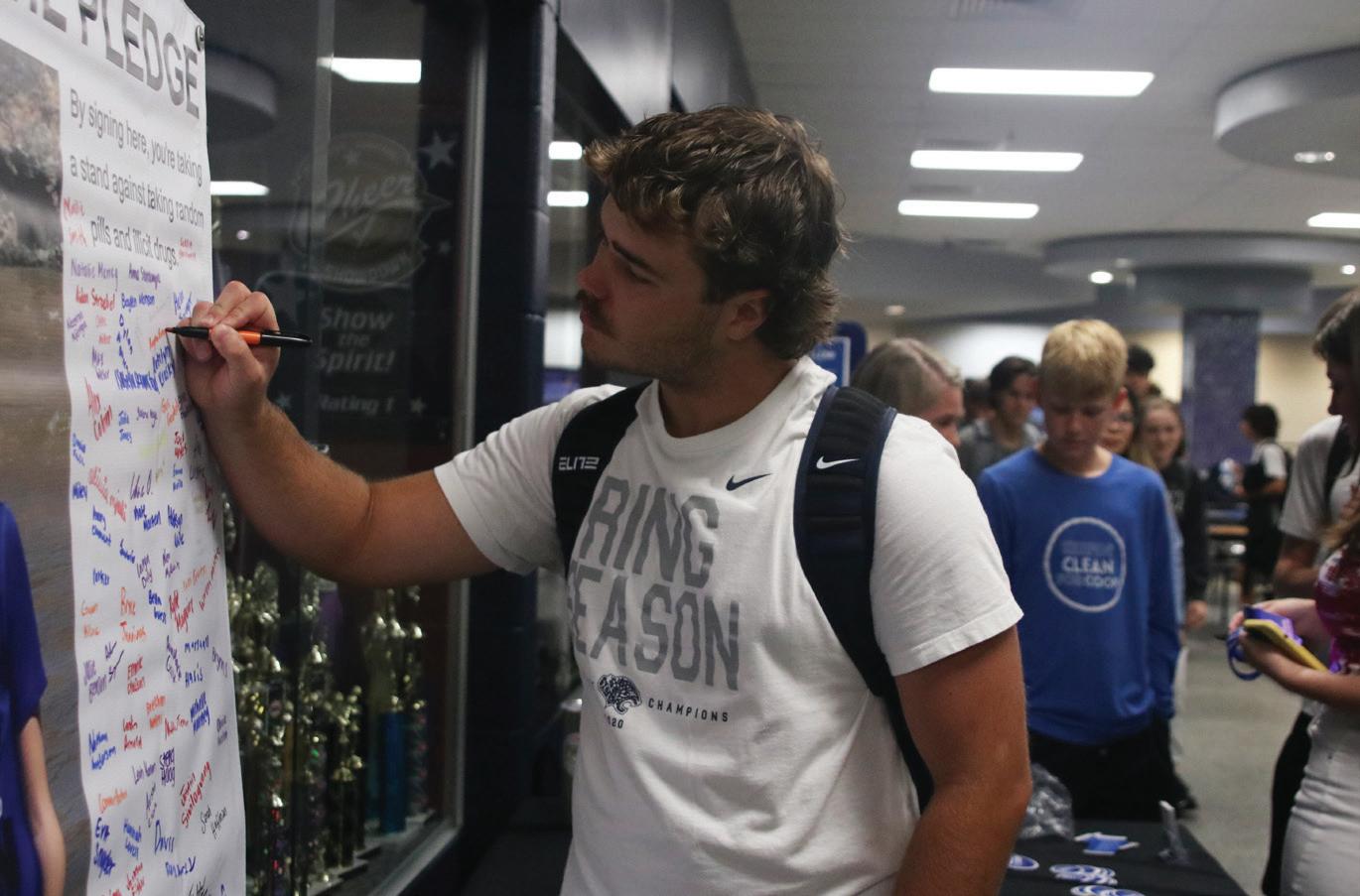
In response to Cooper’s passing, Libby, students and others with a connection to Cooper’s story have turned their grief toward a solution, a campaign that strives to reach teens all over the Midwest to educate them on the dangers of illicit drugs, especially Fentanyl. The campaign that started as a simple bumper sticker has grown into a non-profit organization working towards improved legislation and protection of adolescents regarding drug usage and sales.
Whether Cooper’s story is represented by a blue “Keepin’ Clean for Coop” t-shirt worn by students, teachers or parents around school or the dozens of Sharpie-written signatures covering a pledge against using drugs, sitting outside of the counseling office, Libby’s work over the last year has served to ensure that her son’s memory can prevent future deaths.
THE CAMPAIGN
Less than a month after Cooper’s passing, the DEA’s widespread “One Pill Can Kill” statement captured the attention of the Davis family, sparking a desire to make something good out of Cooper’s death and help spread awareness to other families about the dangers of Fentanyl.
The Davis’ mission to spread awareness over their son’s death started as a simple round blue bumper sticker that read “Keepin’ Clean for Coop”. This sticker was originally designed in the hopes that its message would
circulate throughout the community.
“We want Cooper’s death not to be in vain,” Libby said. “Something good has to come out of this tragedy. We can’t count that [our campaign] has saved any lives. We believe that more people know about Fentanyl and the dangers of Fentanyl today than they did a year ago, so that just keeps us moving forward. We just want [Cooper’s] story to be a cautionary tale.”
Cooper’s memory grew into a non-profit organization focused on spreading awareness through several social media pages, informational school assemblies and a digital billboard hanging over I-70. Although the organization has a new name, The Cooper Davis Memorial Foundation, it still uses its original slogan to spread awareness.
Since the initial send out of the DEA’s “one pill can kill” message, the Davis family has held on to that
After the passing of student Cooper Davis, Libby Davis hopes to spread awareness
Along with his peers, senior Keegan Gracy signs the pledge against drugs in the commons Monday, Aug. 22. Submitted by Casey Cunningham
Sept. 27, 2022SPECIAL SECTION8
JagWire statement in every effort they’ve taken to spread Cooper’s story in hopes that it reaches teens at risk and in need.
“We recently just got a nonprofit designation,” Libby said. “So we do officially have a nonprofit organization. It’s called the Cooper Davis Memorial Foundation. But our logo that we’re using is that original bumper sticker called ‘Keepin’ Clean for Coop.’”
Senior Lauren Aycock, who was a close friend of Cooper’s, believes that the Cooper Davis Memorial Foundation has been a successful campaign so far.
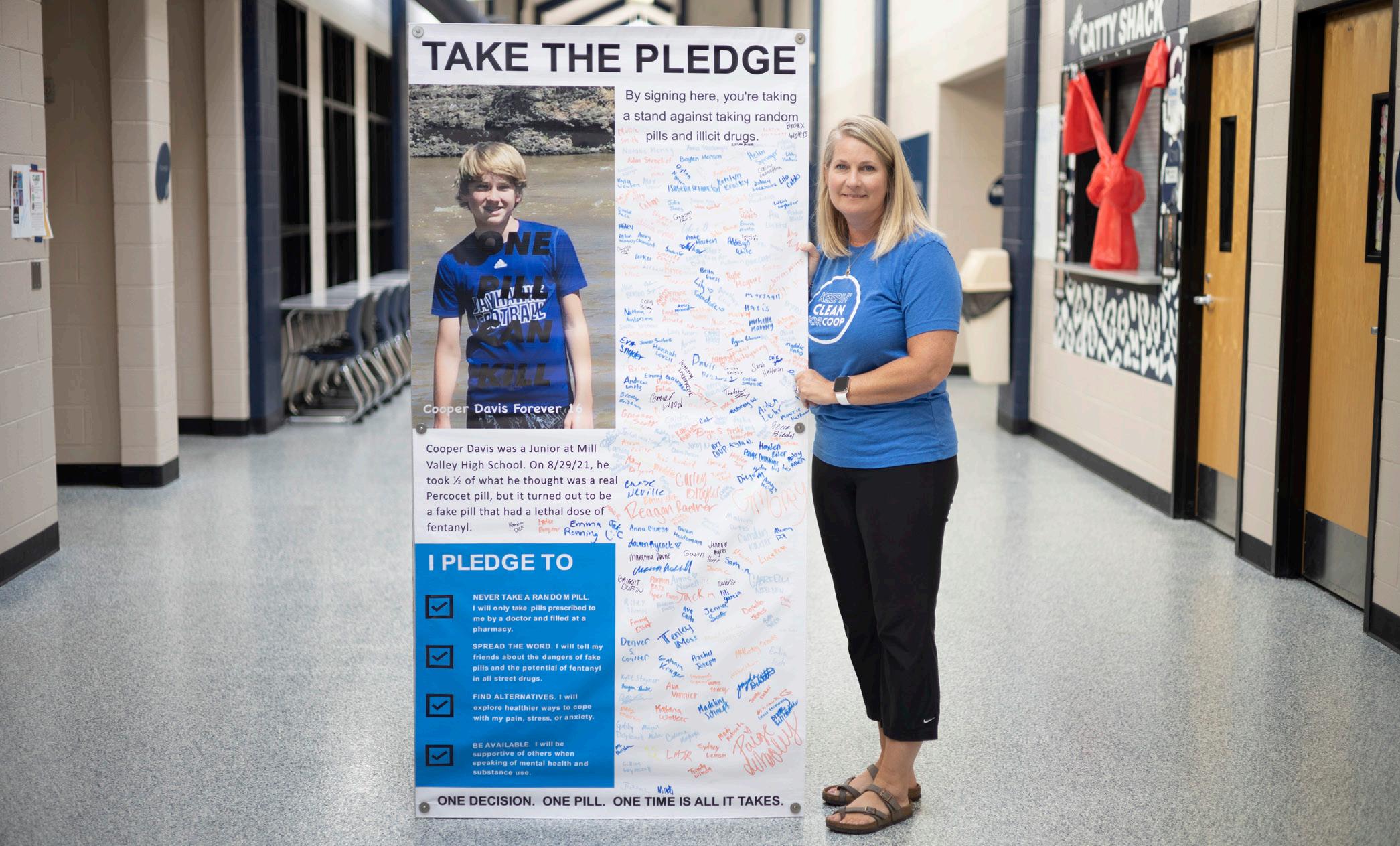
“I think [Cooper’s] family has done a great job, they do so much,” Aycock said. “They’re so involved with the school. His parents are such sweet people. I know getting the awareness out really helps them and it’s helped a lot of people. I think they’re doing a great job with all of the things they’re doing just to spread awareness … Even though it’s really sad, I think it has been a great thing for people who are struggling and people who didn’t know the impact of dealing with drugs. It’s been a great learning experience for everyone.”
THE

Traveling from school to school across the Kansas City metro, providing education on the dangers of Fentanyl, Libby has also worked with several politicians to further her cause, including senator Dr. Roger Marshall. Marshall contacted Libby regarding a bill that would require social media companies to report illegal drug deals on their platforms to the Department of Justice, and requested to name the bill after Cooper. On Sunday, Sept. 18, the Cooper Davis Act was introduced in the Senate.
In an interview with KSHB, Marshall hopes that the bill, if it were to become a law, would need no enforcement on account of the mainstream social media platforms taking initiative to report online drug deals.

“I hope we won’t have to [enforce this bill], I hope that they will be proactive,” Marshall said. “Basically, as long as they are cooperating, as long as they’re doing everything in their power to communicate then that would be great. If not, maybe there will be fines. Maybe there will be something beyond that.”
 Design by Chloe Miller SPECIAL SECTION
Holding the pledge on Monday, Sept 12, Libby Davis has spread awareness to the dangers of illicit drugs. Libby says “their campaign is called one pill can kill, we just kind of grabbed on to that statement and we created Keeping Clean For Coop. Photo by Elizabeth Summa
Design by Chloe Miller SPECIAL SECTION
Holding the pledge on Monday, Sept 12, Libby Davis has spread awareness to the dangers of illicit drugs. Libby says “their campaign is called one pill can kill, we just kind of grabbed on to that statement and we created Keeping Clean For Coop. Photo by Elizabeth Summa
9
KEEPIN’ CLEAN FOR COOP
The Cooper Davis Memorial Foundation has formed numerous social media accounts to spread awareness Twitter: @CleanforCoop Website: www.cooperdavismemo rialfoundation.com Instagram: @keepincleanforcoop Facebook: Keepin’ Clean for Coop
LEGISLATION
Social media companies would also be required to save information that would later be used as evidence in investigations. While social media accountability was not an original item Libby planned to cover, she believes it’s the only platform in the hands of lawmakers that can be controlled to mitigate the digital sale of Fentanyl.
“Senator Marshall recognizes [Cooper’s death] as a poisoning, not an overdose, and has really gone to bat in Washington to try to raise awareness and get the current administration to do more to stop the flow of Fentanyl coming into our country,” Libby said. “That is a hard task. The DEA is trying all they can but you know they’re seizing about 20% [of the Fentanyl] coming into our country. That means 80% is still making it in and the 2021 statistic was that the amount they seized last year was enough to kill every American.”
Libby first met with the senator’s team in May. Because she believes social media is not doing enough currently to hold online drug dealers accountable, Libby hopes the bill will get enough support to become a law.
“The Cooper Davis act raises the level of accountability where the social media accounts are supposed to report any drug activity that they see occurring,” Libby said. “It makes them accountable. It’s the Attorney General of the United States that they have to answer to so audits can be performed. The government can
look at their algorithms and decide if they’re doing enough to kind of catch those criminal activities. It’s just a higher level of accountability for the social media apps.”
For Libby, having her son’s name on federal legislation honors him and helps her know something good can come out of tragedy.

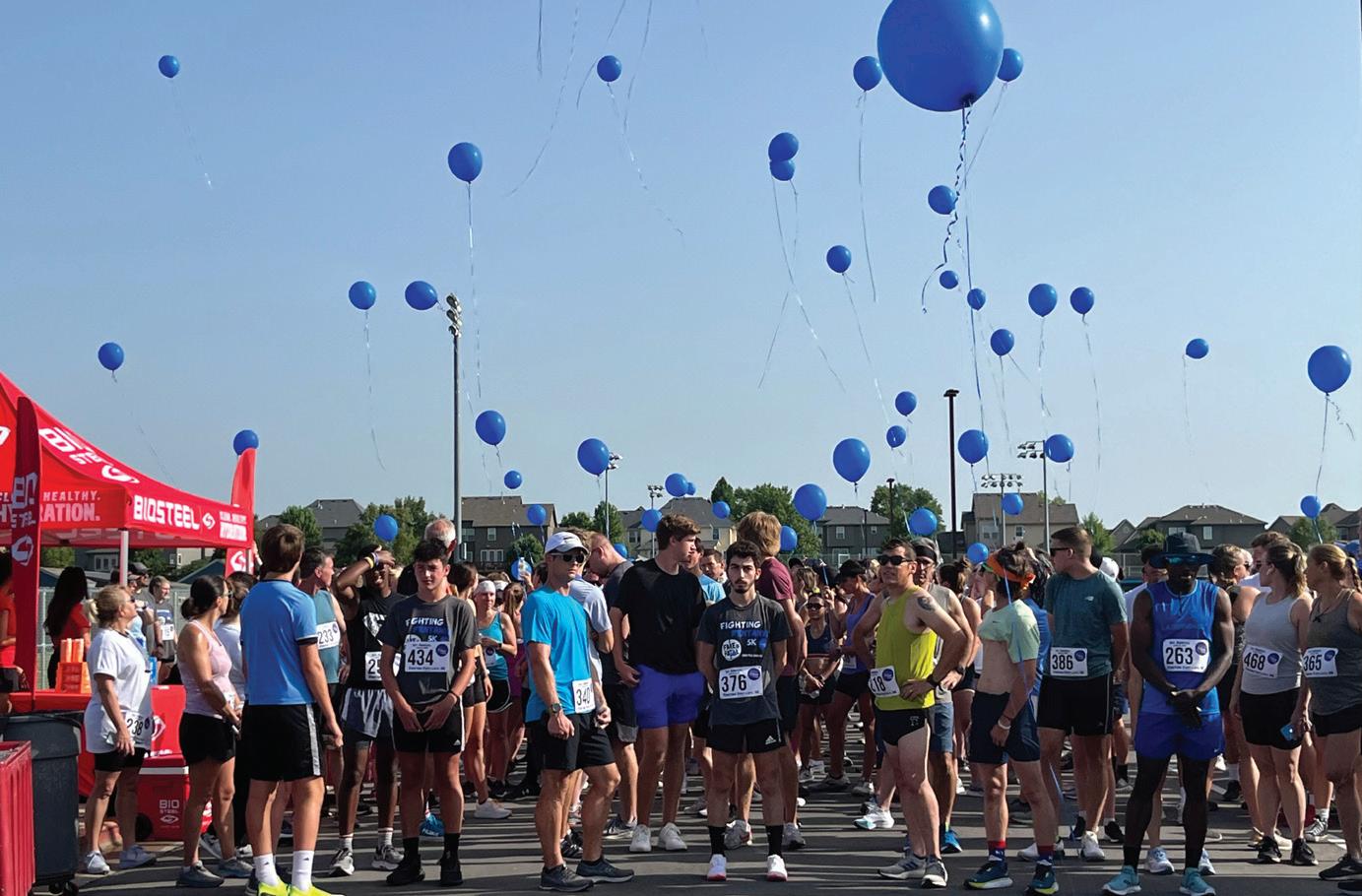
“When I met in May with Senator Marshall’s group, he scheduled a follow up meeting with a couple of his people and they, on the phone, announced to me that they were going
to be introducing this bill, and they asked permission to put [Cooper’s] name on it. And of course, I said yes,” Libby said. “I think it was already in the works. It wasn’t something that I requested. It was their own idea.
When they took it upon themselves to create a bill and asked his name to be put on it, I thought it would save lives.”
In an interview with Fox Business, Marshall’s creation and introduction of the Cooper Davis Act was primarily motivated by the record number of Fentanyl-related deaths over the last year and steps that could be taken to mitigate the Fentanyl crisis.
“This is the number one killer, Fentanyl is the number one killer of young adults. We lost more people last year [2021] than all of the Vietnam War,” Marshall said. We need to stop that type of behavior, we need to hold
Cooper’s father, Randy Davis, thanks the crowd for coming out to the 5k and tells the story of what happened to his son, Cooper Davis, on Saturday, Jun. 18. Submitted by Kathy Habiger
After the blue balloons were released in honor of Cooper Davis, the race participants lined up to begin the 5k on Saturday, Jun. 18. Submitted by Kathy Habiger
Fentanyl is the number one killer of young adults
Senator Roger Marshall
Sept. 27, 2022FEATURES10
social media companies accountable … thousands of these pills are found everyday.”
Cooper and his friends purchased the fake Percocet pills from a drug dealer they connected with through Snapchat. Cooper’s story and many others like his where teens have gotten access to drugs over social media have driven Libby, along with lawmakers behind the Cooper Davis Act to crack down harder on social media platforms for allowing this kind of behavior.
“Social media apps should not be okay with their platform being a vehicle for drug distribution,” Libby said. “Gone are the days of drug deals happening in dark alleys. Being able to purchase a drug that could potentially kill your child is just a few clicks away.”
THE IMPACT
Cooper’s death has had an undeniable impact on the local community, which the Cooper Davis Memorial Foundation hopes to use to continue spreading awareness and keep Cooper’s memory alive.
On Saturday, June 18th, the foundation held the Fighting Fentanyl 5K at Mill Valley. The event raised over $23,000 going toward spreading Fentanyl awareness.
“To us [the Fighting Fentanyl 5K was] an awareness event disguised as a 5K,” Libby said. “The 5K got the people there and gave us the platform to tell Cooper’s story once again.”
Among the community members who participated in the event was junior Audrey Holick, who ran the race with her mom and sister.
“I think [the 5K] was really well done,” Holick said. “I really think they were able to take something so
horrible and make it into something almost positive, something that could change the community. Instead of just focusing on the death, they thought of what they could do with it, and I really like that. I think they did a really good job with it.”
Like Holick, junior AJ Vega also ran in the 5K and has been impressed with the Davis’ family advocacy.
“I think they’ve done a very good job to help [inform people about] how big of an issue this is,” Vega said. “We got a poster of Cooper Davis at the school’s center and people are signing that, which is really cool. I think they’ve done a good job and the 5K was a good, good fundraiser because it’s your to do the exercise and then at the same time you’re fundraising for something that’s a very big issue. [I give] credit to them, they’ve done a lot to help spread awareness.”
Aycock hopes that people will continue to learn from Cooper’s story.
“[Cooper’s death] impacted every person in different ways, no matter how you knew Cooper” Aycock said. “He was one of my best friends forever, we were always together. Some of the people who were around him when he was doing those things, I hope that they learned from him. I just hope everybody takes it however they need to.”
Although Libby recognizes that there are still plenty of steps to take to prevent future deaths, she emphasizes the importance of informing people of the dangers of drug usage.
“There is still a lot of work that needs to be done,” Libby said. “And the only defense we really have is awareness.”
WHAT’S BEING DONE?
The CDC recognizes this pertinent problem and is committed to combating the epidemic
Monitoring trends to better understand and respond to the epidemic
Supporting providers, healthcare systems, and payers with data, tools, and guidance for evidence-based decision-making to improve opioid prescribing and patient safety
FENTANYL FACTS
Fentanyl has the world grappling with one of its worst ever drug crisis
Fentanyl is a synthetic opioid that is 50x stronger than heroin and 100x stronger than morphine
FEATURES 11JagWire Over 150 people die every day due to synthetic opioids like fentanyl
2 mg is a lethal dose of fentanyl

Source: Centers for Disease Control & Prevention
Source: Centers for Disease Control & Prevention
Increasing public awareness about prescription opioid misuse and overdose and to make safe choices about opioids
Partnering with public safety officials and community organizations to address the growing illicit opioid problem
Design by Chloe Miller
RESPECT IN POLITICS
by lucienna writer/photographerguess
Our society is notoriously a no nuance zone and polit ical association is certainly no exception to this. There’s an on going battle between red and blue. It is imperative that we do our part as a generation to realize that there is purple and find solutions to whatev er issues are thrown at us.
I can’t help but think of the story of the founding fathers original fear of political parties. According to his tory.com, after seeing how the then called factions “… ripped England apart in the bloody civil wars of the
parties do work together, real and significant progress can be made.
A recent example of a bipartisan bill signed into law was on June 25, the “Keep Kids Fed Act of 2022,” which extends flexibility for nutri tion programs for school meals and childcare centers.
Even though there are common alities, the competition between conservatives and liberals is compa rable to America in the 1790s, when according to history.com, Democratic-Republicans and Federalists were “bitterly attacking each other” in newspapers about administrative policies, similar to the smear cam paigns that dominate our screens in the modern era.
According to thehill.com, in re gard to President Donald Trump’s election campaign, “Between social media, doctored videos and his ral lies this will be a tear down campaign like nobody has ever seen.” Both to day and in the 1790s the disagree ments within politics are black and white. One party is wrong, one is right and the overlap is ignored. The difference now is that politicians are able to spread abhorrent informa tion quickly due to social media.
DID YOU KNOW?
62% of Americans say they have political opinons they are afraid to share.
According to the CATO Institute, Self Censorship is on the rise. People from all political parties don’t want to share their opinions on certain subjects in fear of offending someone or being judged.
In those controversial conversa tions it is too common to see some one’s ideas being shut down because it does not align with the popular opinion. It leaves people intimidated to share their perspective out of fear of being shut down.


17th century,” the founding fathers desperately wanted to avoid any pos sible division to form the most dem ocratic government possible.
In this time of high tension be tween political parties, we as a coun try have accomplished the first step towards a more democratic govern ment like the one our founding fa thers hoped for, by increasing our political participation. It seems as though everyone has some sort of opinion on current issues. You can see it in the hallways when students have a pro-choice pin on their back pack or a Daily Wire sticker on their water bottle.
Distracted by how people choose to label themselves, the common ground is often ignored. When the
It is crucial to recognize the im portance of sharing your opinion in a beneficial way. This means using logic and research to inform others not only what your opinion is, but how you came to that conclusion. Informing people is not always go ing to convince them to change their opinions. However, it gives them another perspective to weigh against their own.
In order to prevent people from feeling unheard and unrepresented, political tolerance needs to be prac ticed. Contrary to popular belief, political tolerance is not limited to not calling the other person names. It also includes simply listening. Be cause at the end of the day, no mat ter who you are or what political party you are associated with, your ideas and thoughts are not more im portant than your peers. For this rea son it is important to go into every conversation with an open mind and a willingness to listen.
Ultimately, a better world is a bi partisan goal. The best thing about that is, a better world means some thing different to every person. Therefore, political tolerance allows us to create and vote on the best solution for our nation, based on a diversity of ideologies from good conversation.
THOUGHTS AND OPINIONS
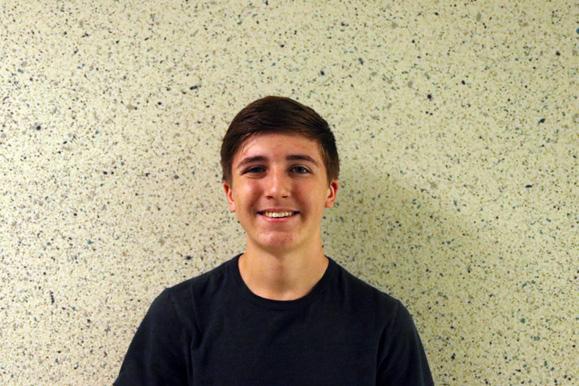
Students answer “what do you think of the oppsoite political party?”
“I don’t know how to say it. But it’s not ideas I agree with, it’s just different ideas, like an amalgamation of differ ent ideas that make up that party. And just the majority of them I don’t align with.”
“As far as other parties go, I believe they can be quite extreme on certain policies. And they don’t ever cooperate to get onto a good middle ground to where their policies are at a good point.”
In a time of political division, the lack of respect in United States politics must change
Design by Grace Brookshire
Sophomore Abigail Gaffeney
Junior Sebastian Smith
It is crucial to recognize the importance of sharing your opinion in a beneficial way.
Lucienna Guess
Sept. 27, 2022OPINION12
CALL ME COACH
Two Mill Valley teachers hired as district’s first female football coaches
 by ian chern writer/photographer
by gabby delpleashonline editor in chief
by ian chern writer/photographer
by gabby delpleashonline editor in chief
Mill Valley teachers Melissa Weber and Michelle McRay both coach the Monticello Trails Middle School 7th grade boys football team. Both have overcome gender barriers and coach in a maledominated sport.
Weber teaches social studies and has always loved the sport of footbal, this is her first experience coaching the sport.
“Monticello is right next door and [social studies teacher Cory Wurtz] gave me the idea to coach [at Monti cello]. He is persuasive so I can always ask him for advice,” Weber said.
Although this is Weber’s first foot ball coaching experience, she has coached other sports before. She coached cross country in her previous school district.

McRay teaches French and coach es girls wrestling. Like Weber, also this is McRay’s first time coaching the sport.
“[Mill Valley football coach Joel Applebee] told me about the job. He asked me if it’s something I would be interest ed in and I had just thought about it. I was actual ly recom mended by [principal Dr. Gail Holder] for the po sition,” McRay said.
Both coach es are excited and are con stantly learn ing. They have unique coaching styles that they implement into their practices and
WOMEN WITH THE WHISTLE
Pro
noticed by the players, like 7th grade football player Lucas Pennel.
“I guess they treat us more like hu mans than the male coaches,” Pennel said.
“I’m less technical with [my team]. I’m more worried about their be haviors, and since I’m still learning so much, I would say I’m more con cerned with their behavior,” McRay said.
Weber and McRay overcame the gender barrier and believe having a female coaching perspective is just as important as a male perspective.
“I think having a female perspec tive when coaching shows both men and women that anyone can do this job. Developing young student ath letes and coaching them shouldn’t be something that is separated by gender and I think people are finally starting to realize just how much women can add to the development of athletes,” McRay said.
Weber and McRay both started coaching football around the same time and enjoy experiencing it togeth er.
“[Coaching with McRay] makes me feel better to know we’re equal and on the same page so we can ask each other questions,” Weber said.
Weber and McRay have both learned import ant lessons from coaching football.
“All of the growth and de velopment aspects and trying to build successful young people, worldly cit izens or whatever you want to call it. That’s the hard part,” McRay said.
Design by Gabby Delpleash
Photos by Kai Tolly SPORTS
13JagWire
CH WEBER
sports are moving closer to having greater female leadership COACH MCRA Men accounted for the remaining 61.8% Source: forbes.com A record number of females joined NFL leadership roles in 2020 Source: nytimes.com Percent of female leadership in other major league sports from 2019 to 2020 41% 30% 25%20% 13% NB AML S ML B NHLWT T
IT’S TIME TO
An app that has users “Be Real” and
once a day has gone viral for its unique take on social media
by abby writer/photographerriggs
Ateacher is instructing their class when all of a sudden, they are interrupted by a class full of excited teenagers. After a stu dent shouts, “Be Real just went off!”, the class all pull out their phones, rushing to post on time.
Be Real is a new social media app that has captivated the attention of students. The app’s premise is sim ple: once a day, at varying times, all users are sent a notification that it is time for them to post an unedited picture of whatever they are doing at that moment. Users then have two minutes to take two pictures.
In the first, they pose for the cam era and take a picture of themselves. In the second, the camera faces the opposite direction and users are able to photograph both directions simul taneously.

Be Real was created as a response
to the current state of social media which is filled with pictures that create a false narrative of what a realistic teenage and young adult life is like. It was originally released in 2020 however, it started to gain popularity with many students in the summer of 2022. It has become so popular that in 2022 alone, the app’s downloads have increased by 315% since its creation two years prior, ac cording to NPR.
One of the app’s most alluring features is its authenticity, according to sophomore Addie Riffel.
“I like how it’s authentic because everyone has it at a certain time and you can’t fake it by editing the pic tures or using filters,” Riffel said. “It shows what people are really doing and shows that everyone isn’t always out doing something cool.”
While seeing others participate in everyday activities can be refreshing, sophomore Porter White particular
ly enjoys the app when his Be Real notification goes off while he is doing something exciting.
“The best Be Real I’ve ever taken was when I took one when I was on top of a mountain,” White said.
On many social media apps, the pressure to always look your best is intense. This same pressure isn’t something that is associated with posting on Be Real, which Riffel finds very refreshing.
“It only happens one time a day so you aren’t on it all of the time. I use it less than I use any other social media,” Riffel said. “There also isn’t the same amount of pressure to look good on it like there is on things like Instagram.”
Riffel hopes the app is here to stay.
“Everyone I know really likes [Be Real] and I don’t think anyone will stop using it any time soon,” Riffel said.
DO’S AND DONT’S An insight on basic Be Real etiquette
Do react to your friend’s Be Real’s Don’t be late on posting the Be Real
When your friend posts, click the circle in the bottom right corner to react to what your friend posted.
The fun part of the app is “being real” and if you’re late to posting, that isn’t very real.
Design by Maggie Wieland
Juniors Samantha Mullen, Allison Mulder, Jenna Graber and Faith Parker take a photo on the new popular app, Be Real, Friday, September 2. Photo by Sydney McGlasson
Sept. 27, 2022A&E14
post a photo
27.1 27.1 The statistics behind Be Real BY THE NUMBERS BY THE NUMBERS million downloads $30 $30 million dollars in investments 74.5% 74.5% of the app’s download’s have occured in 2022 2.93 2.93 million daily app visits BE REAL Source: Marketing Hub
Fun and engaging places to hangout around Kansas City AROUND by anna writer/photographerzwahlen
LENEXA CITY MARKET
with the school year back in full swing, it can be difficult to find a space to study or hang out with friends. The public market at Lenexa City Center serves as both for many students, such as Libby Strathman.
“I usually go there to study and get work done with my friends,” Strathman said. “It’s a great place to go if you need to get stuff done.”
Lenexa City Center has every thing a student needs with close
proximity to the Lenexa Public Li brary, in addition to a wide range of seating and the diverse food court on site.
The market’s later hours and wide variety of food and drinks make it the perfect spot for a late night study session. With seven different stalls ranging from coffee and pastries to pizza and sandwiches, there are plenty of options to choose from.

“It’s a great place to go with peo ple because everyone can get exactly what they want,” Strathman said.
CREATIVE CULTURE
Located in Leawood, Kansas, Creative Culture is just the place to go if you’re looking for something out of the ordinary to do with friends.
Junior Augusta Miller describes it as a great place to hang out and de compress amidst the stress of a busy junior year.
“We thought this would be a per fect thing to do because it lets us relax our minds and just chat while doing a craft,” Miller said.
HOW WE HANG
While enjoying one of eight gour met milkshakes from their menu, you can choose from a wide variety of DIY crafts to work on, including painting, planting and woodwork ing, including kits for the less artis tically inclined. According to Miller, the store’s surrounding area provides opportunities for everyone.

“[Creative Culture’s Leawood lo cation] is surrounded by other great stores and restaurants that you could take your friends to after to continue the fun.” said Miller
Student input on how they spend their time at Creative Culture and Lenexa
“ “
Full of diverse restaurants, the Lenexa public market is a great place to relax with friends and eat some good food. Photo by Maddy Welch
Creative Culture ‘Life of the Party’ milkshake includes birthday cake ice cream, whipped cream, rainbow sprinkles, a vanilla cupcake, dipped waffle cone and a strawberry wafer. Photo by Luke Wood
[Creative Culture] lets us relax our minds while doing a craft.
Junior Augusta Miller
I usually go [to Lenexa City Market] to study and get work done with my friends.
Senior Libby Strathman
Design by Natalie Merley A&E 15JagWire
“
“
ARTISTS AT WORK
Students work on projects in their art classes
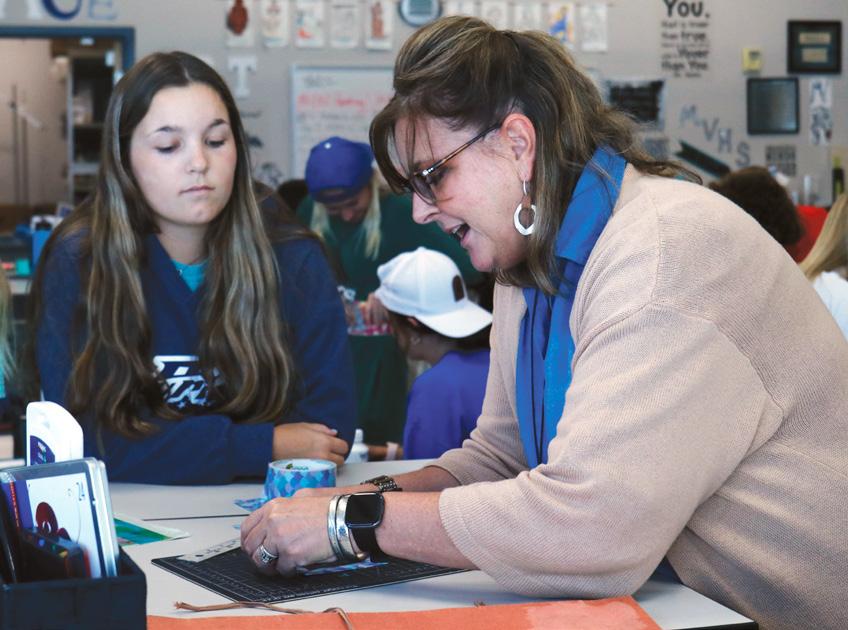
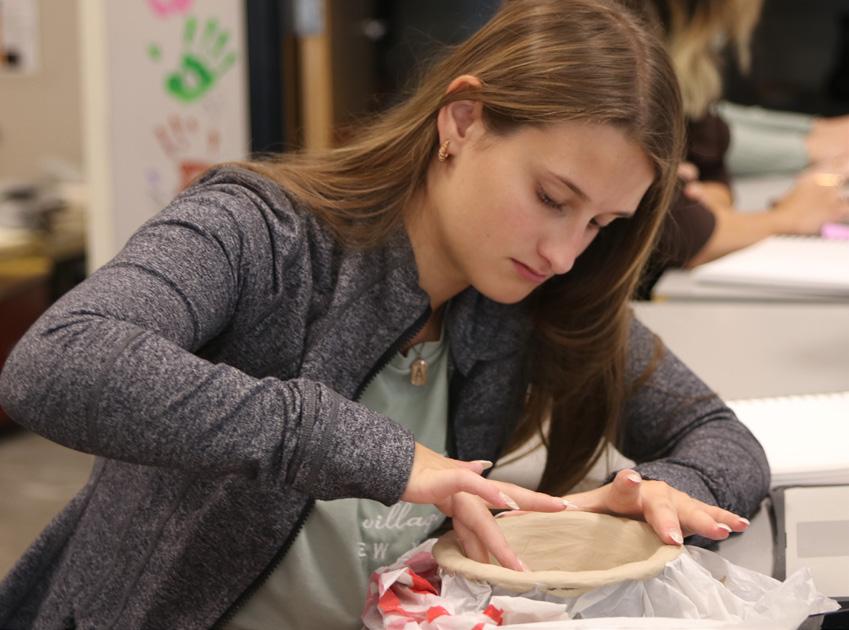

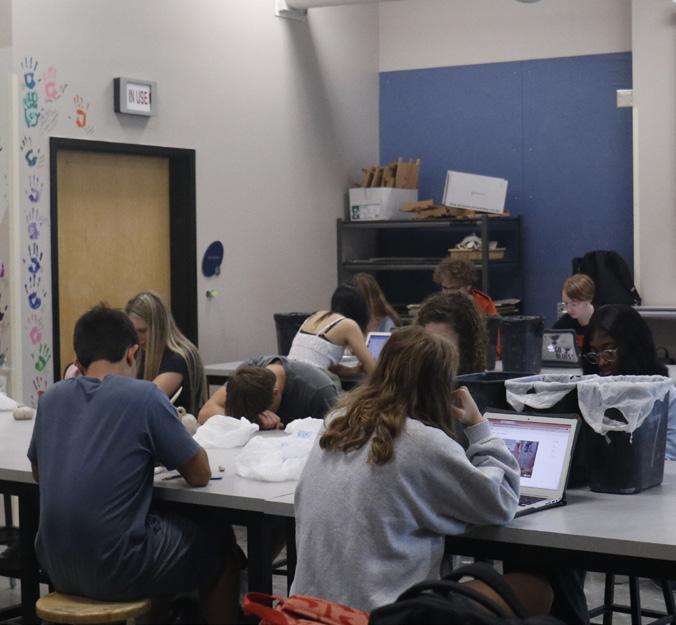

“I like them be cause they are super cute and friendly,” Holland said.
 Refining her paint ing of an otter, freshman Grace Holland in art teacher Krystal Strong’s Art I class Friday Sept.16. “I chose [an otter] because otters have always been my favorite animals.
Photo by Elizabeth Summa
Working on his watercolor painting, freshman Cru Akins shades red and brown paint into his painting in Krystal Strong’s Art I class on Friday, Sept. 16 Photo by Elizabeth Summa
Erica Matyak’s Ceramics 1 class works on making clay pumpkins, while other classmates are watch ing edpuzzles over clay cylinder techniques Sept. 19. Photo by Sydney McGlasson
Freshman Melia Davis adds yellow watercolor to her painting on Sept. 16 in Krystal Strong’s Art I class. Photo by Elizabeth Summa
Sopho more Mol ly Griffin looks to art teacher Jodi Ellis for help on her Duck tape project Monday, Sept. 12 in Survey of Fine Crafts class. Photo by Kai Tolly
Junior Aubrey Wescott uses her fingers to make the sides of the bowl smooth for her clay bowl assignment in ceramics
1 Friday, Sept. 2.
Photo by Sydney McGlasson
Design by Grace Brookshire
Refining her paint ing of an otter, freshman Grace Holland in art teacher Krystal Strong’s Art I class Friday Sept.16. “I chose [an otter] because otters have always been my favorite animals.
Photo by Elizabeth Summa
Working on his watercolor painting, freshman Cru Akins shades red and brown paint into his painting in Krystal Strong’s Art I class on Friday, Sept. 16 Photo by Elizabeth Summa
Erica Matyak’s Ceramics 1 class works on making clay pumpkins, while other classmates are watch ing edpuzzles over clay cylinder techniques Sept. 19. Photo by Sydney McGlasson
Freshman Melia Davis adds yellow watercolor to her painting on Sept. 16 in Krystal Strong’s Art I class. Photo by Elizabeth Summa
Sopho more Mol ly Griffin looks to art teacher Jodi Ellis for help on her Duck tape project Monday, Sept. 12 in Survey of Fine Crafts class. Photo by Kai Tolly
Junior Aubrey Wescott uses her fingers to make the sides of the bowl smooth for her clay bowl assignment in ceramics
1 Friday, Sept. 2.
Photo by Sydney McGlasson
Design by Grace Brookshire
Sept. 27, 202PHOTO ESSAY16
